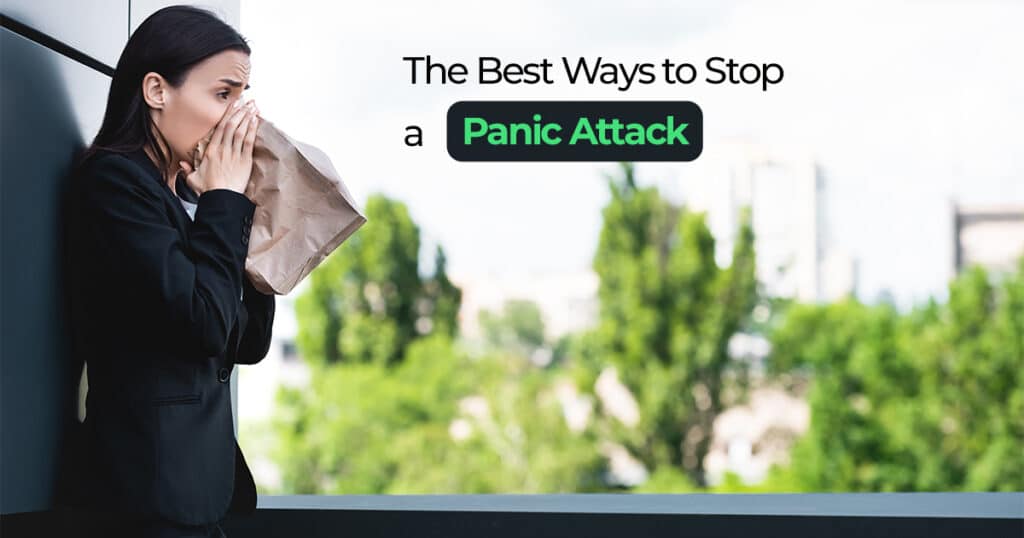Panic attacks are defined as the sudden onset of fear or anxiety, often paired with physical symptoms, based on a perceived threat rather than a certain danger. Panic attacks might feel like a heart attack. Symptoms include chest tightness, rapid heartbeat, sweating, trembling, shortness of breath, nausea, chills, abdominal cramping, headache, dizziness, vertigo, hot flashes, and sweating. This article will go over the best ways to stop a panic attack.
How to Stop a Panic Attack After it’s Already Begun
Neurologically, panic attacks may be related to the fight-or-flight response in the amygdala of the brain, which is responsible for survival instincts. But if these panic attacks arise without any real danger, they can be debilitating. It doesn’t have to be this way—there are several ways to stop a panic attack, even after it has already begun.
Mental Health Center of San Diego
1. Use deep breathing techniques
Many individuals experiencing a panic attack report hyperventilation and a fast heartbeat. One way to remedy this is to focus on the breath, rather than racing thoughts, by making breaths deeper and longer. Deep breaths come from the diaphragm and not the chest. Diaphragmatic breaths will show the belly rising and falling more dramatically, rather than the chest area.
One study showed that people who regularly engaged in diaphragmatic breathing showed lower cortisol levels, the stress hormone, than those who did not engage in the practice. To practice this at home, inhale for a count of four, hold for one, and then exhale for four. Repeat this at least twenty times, or until symptoms subside.
2. Change your setting
External stimuli may cause panic attacks; it can be helpful to change location to alleviate these stressors, even if that means going to the bathroom to find some quiet and calm for a few moments. If it is possible to move a bit more, though, it can be helpful to take yourself to a totally different context—going from indoors to outdoors or vice versa.
Fresh air can do wonders for a racing mind. Think of an accessible, happy place—your apartment with snuggly pets, a library with books to browse, or a pastry shop with your favorite doughnuts; changing your environment can be essential to redirecting your mind and offsetting panic symptoms.
3. Block out your senses
Panic attacks are often triggered by external sensations, such as a hectic visual scene or loud noises. If it is impossible to change your setting, try to block out your senses and come to a space of peace and quiet in your mind. Close your eyes and focus on the blackness. If you have earplugs or earphones, put those in your ears to block out external stimuli.
4. Exercise
Panic attacks often manifest as an exertion of pent-up energy. Fast heart rate, profuse sweating, the need to move. Going for a run, heading to the gym, dancing in your room, taking your dog for a walk—any of these activities give your body an outlet to get rid of stockpiled adrenaline and cortisol.
5. Keep soothing products on hand
Lavender has been used for thousands of years as a natural relaxation remedy. You can put small amounts of diluted lavender essential oil on the inside of your wrist, your chest, or the side of your neck—places where your pulse is prominent.
The scent of lavender has an immediately calming effect known to help tremendously with panic attacks. Since the FDA does not regulate essential oils, be sure to get yours from a reputable source, follow the dosage instructions on the bottle, dilute it with coconut oil or water, and avoid applying too much.
Other individuals who suffer from panic attacks report using cannabidiol (CBD), the inactive ingredient in cannabis, to relieve stress symptoms. CBD now comes in various forms—pills, tinctures, snacks, drinks, lotions, oils, and more.
Mental Health Center of San Diego
6. Practice mindfulness and meditation
Mindfulness is the act of becoming aware of the present and grounding yourself. This might involve focusing on one object or activity, acknowledging your emotional state, and engaging in meditation. Mindfulness has become a popular tool in Cognitive Behavioral Therapy (CBT) and has been shown to reduce stress, panic, and anxiety effectively. One example is the 5-4-3-2-1 method:
- Look at 5 different objects
- Listen to 4 distinct sounds
- Touch 3 separate objects
- Smell 2 diverse scents
- Taste 1 thing
This method is used to become conscious of reality by focusing your mind on sensations rather than perceived threats. Several online meditation options are accessible via your internet browser or a mobile app—for free!
7. Tell someone
Experiencing a panic attack without telling anyone can make the situation even more isolating. Try to excuse yourself to a friend’s cubicle at work or call a friend at home to tell them. Sometimes the best way to erase these feelings is to express them to someone.
Friends and family know us best and might offer unique ways to help us feel better. Coworkers could find a quiet conference room to sit and find some calm. Friends might bring your favorite food or send a calming music playlist.
How to Prevent a Panic Attack
It is also possible to prevent panic attacks before they even occur. Here are some ways to minimize the chances of experiencing a dreaded panic attack.
1. Avoid stimulants
Stimulants such as caffeine and nicotine can cause the body to speed up its natural response and in turn, yield racing thoughts and panic. Recreational drugs and alcohol can also cause panic attacks. If you’re prone to panic attacks, it is best to stay away from these substances. If you’re a regular coffee drinker, try opting for decaf options.
2. Engage in healthy habits
Regular exercise allows your body to expend built-up energy before it channels into a panic. Eating healthy foods with not too much sugar will also help your body regulate its hormone levels and keep energy levels steady.
3. Learn your triggers
If panic attacks start to occur regularly, notice the variables present that may be contributing to these feelings of unrest. Maybe it’s large crowds, heavy traffic, or significant expenses. It’s important to notice these things so you can avoid them, or at the very least, prepare yourself with calming techniques.
Mental Health Center of San Diego
Getting Help for Anxiety in San Diego, CA
A lot of these ways to stop a panic attack can work for anxiety attacks or general stress reduction as well. If you are prone to panic attacks, it is helpful to keep these mitigation and prevention methods nearby in case you find yourself suffering from panic attacks. But the best way to help panic attacks is by calling (858) 258-9883 and talking to a member of the Mental Health Center of San Diego team about treatment options specifically for you.









